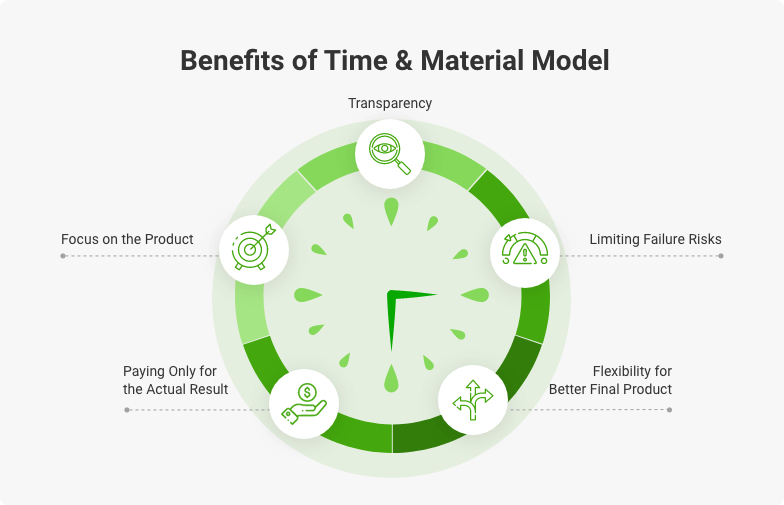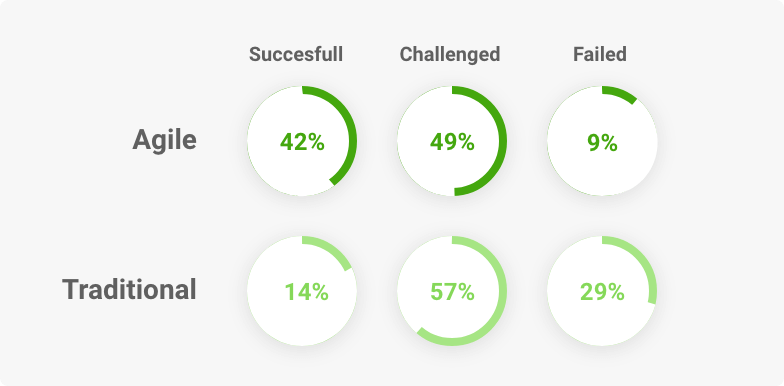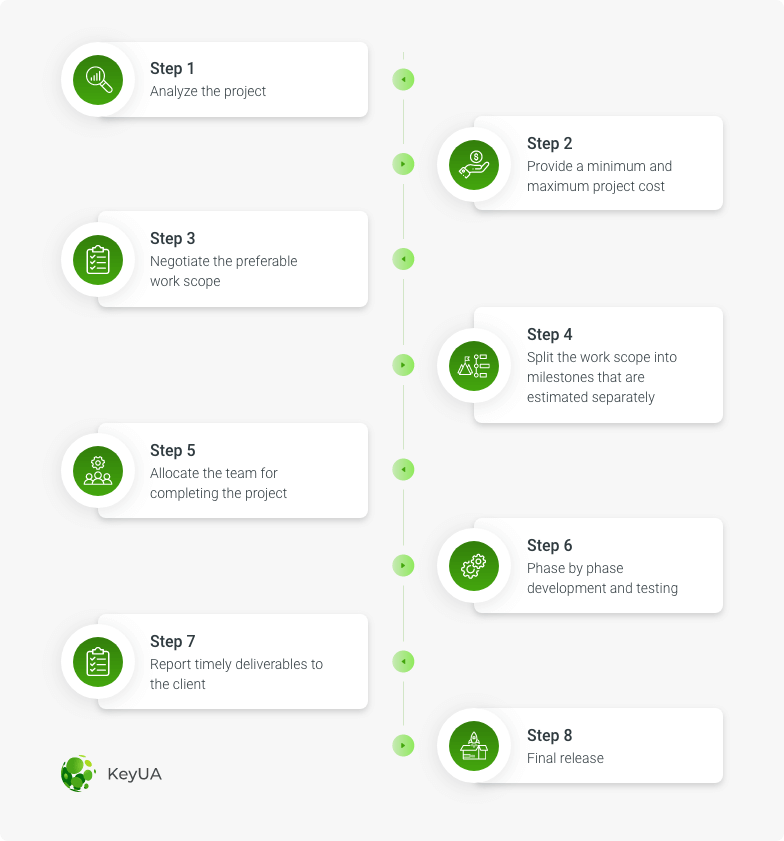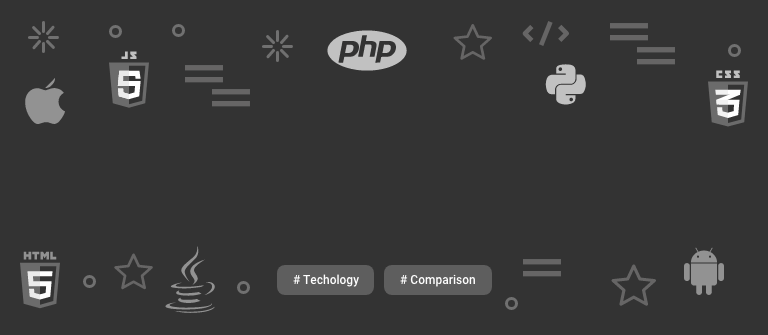When it comes to outsourcing software development, customers usually choose between a fixed price and a time and material cooperation model. Traditionally, the first is accepted as less risky and more predictable in terms of the total project cost. However, there are many hidden aspects to consider. How does it really benefit the product owner? How can you optimize the time & material pricing model to get maximum results from your investments? Here is a simple guide on how to choose wisely.
The Key Differences Between T&M and Fixed-Price Models
A fixed-price project implies a predefined price. A client provides detailed project specs with all requirements defined, and the software design firm agrees to complete the project at a fixed budget.
The time and material model implies paying for the actual time spent on a project. It is also called an hourly-based payment model. A client doesn’t need to define the entire scope of work with all specs detailed before the project starts. Here is a short comparison of these two approaches:
| Time & Material | Fixed Price | |
| Project size | Medium to Large | Small to Medium |
| Development Methodology | Agile | Waterfall, Kanban |
| Requirements | Changing | Defined |
| Timeframe and Budget | Flexible | Fixed |
| Client’s control over the process | Significant | Little to none |
| Payments | “Pay as you go” | In advance |
Alt: Time & Material vs. Fixed Price Cooperation Model
Both models are widely used today. However, most development companies and most entrepreneurs prefer the T&M approach, and not without reason.
Time & Material Model Benefits: Why is NOT Deciding Upfront Better?
On the one hand, a businessman decides to invest in software development. They want to get a top-quality product at a minimum cost. On the other hand, we have an outsourcing partner that aims to satisfy the client’s requirements and deliver a properly functioning product and wants to get fair compensation for its services. See how the T&M pricing model helps to balance the expectations of both parties.

Time-and-Material Model Pros
#1 Focus on the Product
Being strictly limited in time and budget within a fixed-price model, the development team often has to deal with numerous challenges not directly targeted at the final product quality. When choosing between fitting in the initial specs and developing some advanced functionality to boost usability, most likely, they will do the first. The fixed-price model leaves no resources for improvements beyond the defined scope.
In the T&M approach, the team has no such problem. All improvements can be negotiated with a client and approved for implementation on the go. And it works in both directions: a client also can change the conditions or request additional work from the team if they find it reasonable for the final result.
#2 Limiting Failure Risks
As you see from the above table, the time & material model aligns with an agile project management methodology. In contrast, the fixed-price model deals with a more traditional waterfall approach. According to the latest CHAOS Report 2020 from The Standish Group, Agile projects are more successful. There are fewer challenges and failures compared to waterfall projects:

Success and Failure Rates Among Agile and Traditional Projects 2020
#3 Transparency
One of the main misconceptions is that knowing the final software project cost beforehand eliminates the risk of losing money. But knowing the exact amount you need to spend doesn’t guarantee you will be satisfied with the final result.
Since a fixed-price scheme implies the client’s involvement in the development process only at the initial planning phase, you won’t have control over the progress. In a time and material contract, you get significant transparency. You will be aware of where exactly the team is at any point. If you see something is going wrong, you can discuss it directly and let the team make all necessary advancements.
#4 Paying Only for the Actual Result
A fixed price approach gives on-time and on-budget product delivery. At first glance, it seems like an excellent opportunity for investors to save money on software development. Don’t think that ‘fixed’ is always cheaper than ‘hourly.’ An outsourcing company may overestimate the project scope, which may result in a higher payment than the actual project cost to cover all potential risks. T&M contracts are paid on an hourly basis only for the work actually completed.
#5 Flexibility for Better Final Product
The ability to change the project requirements on the go using the T&M model helps keep the product up-to-date within the changeable market. Often great ideas arise while the team is already working on the development. You get deeper into the product specifics and see all hidden opportunities to make it better. It is tough to declare every tiny detail upfront, especially if you are creating a complex, multi-functional solution. In the T&M approach, adding some new functionality or simplifying the initial user stories is not a problem.
Time & Material Approach Drawbacks
Despite all the benefits, there are certain risks in using the T&M business model for software development:
- Deep involvement in the workflow: for some clients, daily and weekly reports, meetings, and planning sessions can be exhausting.
- Unclear deadlines: developing the product without a strictly defined work scope at the beginning can shift the release date significantly.
- Undefined budget: vague initial requirements and lots of changes ‘on the go’ bring uncertainty to how much the project may cost.
The good news is that these aspects are usually negotiable. A client can narrow down the possible budget range and timeframe. The clients’ involvement in the process also can be set comfortably for them.
T&M Approach in Action
Here is how the time and material model is applied in practice. The typical development process by this scheme involves the following steps:
- Analyze the project
- Provide a minimum and maximum project cost
- Negotiate the preferable work scope
- Split the work scope into milestones that are estimated separately
- Allocate the team for completing the project
- Phase by phase development and testing
- Report timely deliverables to the client
- Final release

Applying the time and material model step by step
As you see, the uncertainty of the final budget and timeframe is minimized by providing the client with total and by-phase estimations. Appropriate communication during the entire process helps to keep up with the client’s expectations effectively. This way, you can plan your budget and get the project done by the desired release date.
Conclusion
The flexibility of the time and material payment model helps deliver a top-quality product while minimizing the potential risks for a client.
Because of our result-oriented approach, the KeyUA team applies the best agile practices for project management. We will find the best form of cooperation specifically for your project. Reliability, convenience, and technological power are what KeyUA can bring to your next product development.
Would you like to choose the best cooperation model for your custom project? Consult the KeyUA experts.
Contact Us







 Unit 1505 124 City Road, London, United Kingdom, EC1V 2NX
Unit 1505 124 City Road, London, United Kingdom, EC1V 2NX

Comments
Leave a comment